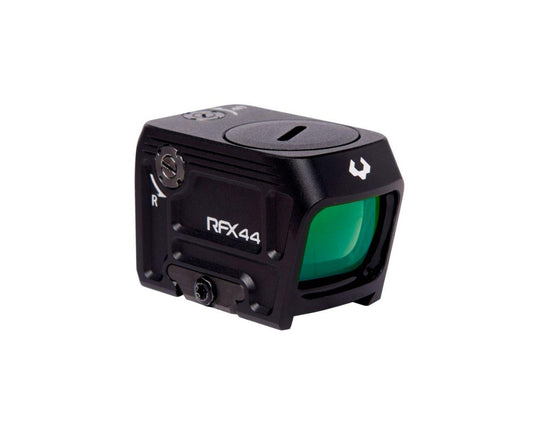

Viridian RFX44 Compact Closed Emitter Green Dot Sight features a 5 MOA green dot reticle, specifically designed for quick target acquisition. The multi-coated lens enhances visibility and clarity, even in challenging light conditions. Its compact design integrates top-mounted electronics to maximize your viewing area while maintaining a sleek profile. Built with modern shooters in mind, this sight prioritizes both performance and convenience.
The closed emitter structure minimizes delays commonly found in reflex sights, ensuring immediate readiness. Constructed from durable 6061 aluminum, it withstands dust and moisture, providing reliable performance in various environments. Additional features like auto shut-off and INSTANT-ON functionality extend battery life, while tactile adjustments allow for precise control, helping you stay focused on your target.
Features:
- GREEN DOT ADVANTAGE for swift targeting and improved accuracy with a 5 MOA reticle.
- CRYSTAL CLEAR OPTICS with proprietary green multi-coated lens for superior color transmission.
- ENHANCED VIEWING thanks to top-placed electronics that optimize the sight’s profile.
- CLOSED EMITTER SUPERIORITY that protects against environmental factors, ensuring reliability.
- BUILT FOR A TACTICAL ADVANTAGE using robust 6061 aluminum for long-lasting durability.
- INSTANT-ON ACTIVITY that guarantees immediate readiness for any shooting scenario.
- Tactile ADJUSTMENTS for user-friendly controls that enhance shooting accuracy.
- LIGHTWEIGHT DESIGN for effortless mounting on your firearm without compromising balance.
Technical Specifications
| Specification | Details |
|---|---|
| Magnification | 1x |
| Lens Diameter | 44mm |
| Weight | 5.1 oz |
| Dimensions | 5.6 x 2.3 x 2.5 in |
| Material | 6061 Aluminum |
What’s in the Box?
- Viridian RFX44 Compact Closed Emitter Green Dot Sight
- Picatinny Low Mount
- Lens Covers
- Instruction Manual
Customer Reviews
"The clarity and ease of use have completely transformed my shooting sessions!" - A. Johnson
"Finally, a sight that delivers on its promises. Highly recommend it!" - M. Smith
FAQ
1. How does the closed emitter design affect performance?
The closed emitter design prevents elements like dust and moisture from interfering, allowing for quicker dot acquisition and consistent performance in various environments.
2. Is it easy to adjust the sight?
Yes! The RFX44 comes with tactile and audible controls, making adjustments intuitive and straightforward, ensuring you can maintain accuracy in the field.
3. How does the RFX44 compare to other red dot sights?
The green dot reticle offers faster target acquisition due to the eye's sensitivity to green wavelengths, along with superior clarity from its multi-coated lens.
Similar Models
Looking for more options? Discover our extensive lineup of Viridian optics, including the Viridian RFX35 for a more compact choice and the RFX45 for enhanced features. Explore our full collection today and find the perfect optic for your shooting needs!
You May Also Like
Here’s some of our most similar products people are buying. Click to discover trending style.






